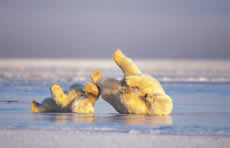About Polar Bears
Perhaps more than any other animal, polar bears are purely creatures of the icea remarkable, ephemeral terrain that comes as a gift of cold. – Richard Nelson, author and conservationist
Special adaptations
Polar bears are marine mammals, superbly adapted to life on or near sea ice. Thick layers of fur and fat keep them warm. Their creamy color serves as a camouflage. Large, flat paws act as snowshoes and swimming paddles. Acute eyesight, excellent hearing, and a keen sense of smell help guide them to their preyeven in the winter darkness.
Shrewd and ingenious hunters
Polar bears use the ice as a platform to track and prey upon seals. Spring is their most important hunting season. They take advantage of the new burst of life on the thin ice over the continental shelf to fatten themselves up in preparation for the lean hunting months of summer. When food is short, polar bears can slow their metabolism for survival.
Ice isn't optional
Descended from grizzlies, polar bears have evolved over 250,000 years to thrive on the ice-covered Arctic Ocean. However, unlike their grizzly ancestors, polar bears are not equipped to survive solely on land. They need the iceand the blubber-rich animals that congregate thereto survive.
More Facts:
- Polar bears are the world's largest land carnivores: Grown male polar bears can weigh up to 1,700 pounds—as much as a horse or small plane!
- Polar bear cubs weigh less than two pounds at birth. They weigh about 25 pounds when they leave the den.
- Polar bears can be found throughout the Arctic in the United States (Alaska), Canada, Russia, Denmark (Greenland), and Norway.
- Thanks to special adaptations, such as a thick layer of blubber, two layers of fur, compact ears, and a small tail, polar bears can withstand temperatures as low as -50° Fahrenheit.
- Polar bears use snow like a towel. First they shake off the water; then they roll in the snow to dry off.
- A keen sense of smell helps polar bears hunt—they can sniff out seal breathing holes from several miles away.
- Polar Bear's Scientific name is Ursus maritimus.
- Scientists estimate that there are between 20,000 to 25,000 polar bears.
- Polar Bears live an average of 15 to 18 years.
- Polar Bear's primary prey are ringed seals and bearded seals.
- Polar Bear's fur is not white. Each hair is clear hollow tube.
- Polar Bears are not territorial - they don't fight over territories.
- Polar Bears have an extremely well-developed sense of smell.
- Polar Bears are excellent swimmers.
|

A sow and cub slide on the ice (autumn, coastal plain, Arctic National Wildlife Refuge)
Photograph by Steven Kazlowski
|

